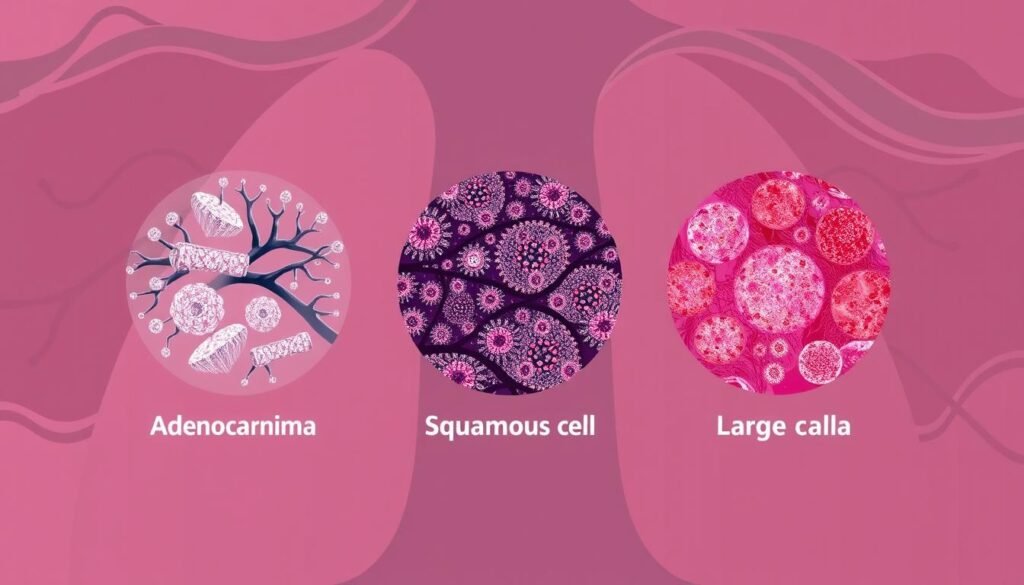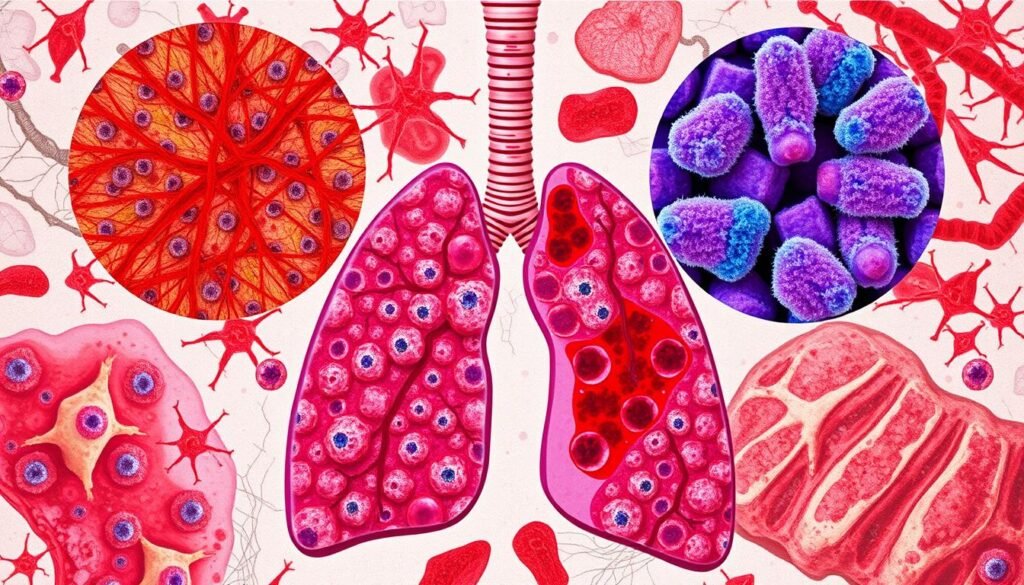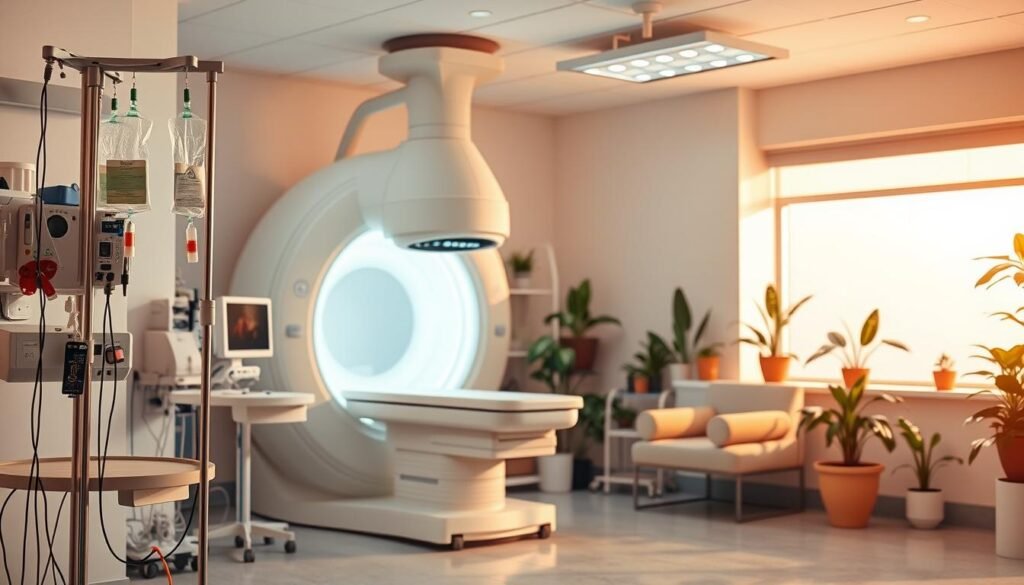About 80 to 85 people out of every 100 with lung cancer have non-small cell lung cancer (NSCLC). This fact shows why it’s crucial to know about the types of lung cancer. Knowing about the classification of lung cancer types helps people make informed decisions in their cancer fight.
Lung cancer comes in many forms, with Non-Small Cell Lung Cancer and Small Cell Lung Cancer being the top ones. Looking into lung tumor classification shows how different types impact treatment, outcomes, and what patients go through. It’s key in both medical talks and finding ways to cope.
To learn more about lung cancer types and get resources for patients, go to the American Cancer Society. Understanding these details is vital in dealing with this tough health issue.
Key Takeaways
- About 80-85% of lung cancers are non-small cell lung cancer (NSCLC).
- Non-small cell lung cancer includes adenocarcinoma, squamous cell carcinoma, and large cell carcinoma.
- Small cell lung cancer (SCLC) is mainly caused by cigarette smoking and spreads fast.
- Adenocarcinoma is the main lung cancer type in non-smokers.
- Knowing the different lung cancer types is key for choosing the right treatment.
Introduction to Lung Cancer
Lung cancer is a major health issue in the US, leading to many deaths. Every year, about 225,000 people get diagnosed. Sadly, lung cancer takes away around 160,000 lives annually. This highlights the need for awareness and early detection.
Most lung cancer cases are linked to smoking, which causes about 90% of cases. Even passive smoking can raise the risk by 20 to 30%. Other risks include exposure to asbestos and radon. These factors make lung cancer a big concern worldwide.
Men are more affected by lung cancer than women in the US. Since 1987, lung cancer has caused more deaths in women than breast cancer. A lot of cases are found in less developed countries. The American Cancer Society expects over 234,000 new cases and nearly 154,000 deaths in the US every year.
We can classify lung cancers using the WHO’s system. This helps in understanding the disease better. Stopping smoking and better screening are key to fighting lung cancer. Quitting smoking lowers the risk of heart disease, stroke, and improves health overall.
What is Lung Cancer?
Lung cancer starts in the lungs, affecting tubes and tiny air sacs essential for breathing. It includes different types, with Non-Small Cell Lung Cancer (NSCLC) making up most cases. There are also Small Cell Lung Cancer (SCLC) and rare kinds like carcinoid tumors.
Signs of lung cancer symptoms are a lasting cough, pain in the chest, and losing weight without trying. At first, these symptoms might be hard to notice. But as time goes on, the person may find it hard to breathe and cough up blood.
Knowing what causes lung cancer is key to stopping it early. Cigarette smoking is the biggest risk, especially with SCLC. Elements like radon, asbestos, and secondhand smoke are also dangerous. If lung cancer runs in the family, it’s more likely one might get it too.
| Type of Lung Cancer | % of Cases | Common Characteristics | Associated Risk Factors |
|---|---|---|---|
| Non-Small Cell Lung Cancer (NSCLC) | 80% – 85% | Includes adenocarcinoma, squamous cell carcinoma, and large cell carcinoma | Smoking, secondhand smoke, exposure to toxins |
| Small Cell Lung Cancer (SCLC) | 10% – 15% | Aggressive, often linked to heavy smoking | Cigarette smoking, environmental factors |
| Lung Carcinoid Tumors | Less than 5% | Slow-growing, less common | Less defined, but potential hormonal factors |
| Other Rare Types | Varies | Adenoid cystic carcinomas, lymphomas, sarcomas | Various, depending on the tumor type |
Common Types of Lung Cancer
Lung cancer comes in different forms, each with its own traits and treatments. Knowing these types helps us understand lung cancer better.
Non-Small Cell Lung Cancer (NSCLC)
Non-small cell lung cancer is the most common, making up 90% of cases. It includes types like adenocarcinoma, which is around 30% of all lung cancers. Squamous cell cancer, another subtype, forms about 30% of NSCLC and usually starts in the middle of the lungs.
Large-cell carcinoma is yet another kind. It’s known for quick growth and spreading. This type makes up 10-15% of NSCLC cases.
Small Cell Lung Cancer (SCLC)
Small cell lung cancer is rare, being less than 20% of lung cancers. It grows quickly and is often linked to smoking. In the U.S., it was 12% of lung cancer cases in 2021. SCLC spreads fast, which makes treatment hard.
Carcinoid Tumors
Carcinoid tumors are not very common, only 1-2% of lung cancers. Most of these tumors grow slowly. This means doctors have a good chance of treating them successfully. However, the atypical ones can spread and are more dangerous.
| Type of Lung Cancer | Percentage of Cases | Notable Characteristics |
|---|---|---|
| Non-Small Cell Lung Cancer (NSCLC) | ~90% | Includes adenocarcinoma, squamous cell carcinoma, and large-cell carcinoma |
| Adenocarcinoma | ~30% | Most common type, prevalent in both genders and age groups |
| Squamous Cell Carcinoma | ~30% | Higher incidence in males, typically central lung location |
| Small Cell Lung Cancer (SCLC) | ~12% | Rapid growth, associated with smoking |
| Carcinoid Tumors | ~1-2% | Slow-growing, typically benign, but some atypical variants can metastasize |
Classification of Lung Cancer Types
When we talk about lung cancer, we look closely at the cells under a microscope. This method tells us a lot. It helps pick the right treatment and guess how well someone might recover. Knowing the kinds of lung cancers is key to handling them well.
Histological Classification of Lung Cancers
Lung cancers come mainly in two types: non-small cell lung cancer (NSCLC) and small cell lung cancer (SCLC). NSCLC is more common, making up about 85% of cases. On the other hand, SCLC includes 10% to 15% of all lung cancer occurrences.
Under NSCLC, there are a few subtypes we see:
- Adenocarcinoma: This makes up about 40% of lung cancers, often in non-smokers, especially among women.
- Squamous cell carcinoma: It is 25% to 30% of lung cancers but is becoming less common.
- Large cell carcinoma: This is the rarest type of NSCLC, accounting for 10% to 15% of cases.
Bronchial carcinoids are not very common either, making up to 5% of lung cancers. They usually occur in younger people and are not related to smoking. Knowing these differences helps in classifying lung cancer types. This knowledge is crucial for creating specific treatment plans.
Differentiating Lung Cancer Types
It’s crucial to tell lung cancer types apart to treat them well. For an accurate diagnosis, doctors use imaging and biopsies. These methods show if it’s non-small cell lung cancer (NSCLC) or small cell lung cancer (SCLC).
About 80% of people with lung cancer have NSCLC. This includes several types, like adenocarcinoma, squamous cell carcinoma, and large cell carcinoma. Adenocarcinoma is the most common in the U.S., being 40% of cases. Meanwhile, SCLC, quick to grow and spread, is about 15% of cases.
Knowing the cancer type well changes treatment plans. For those with lung cancer, knowing your specific type helps doctors create better care plans. This focuses on each person’s unique situation.
Diagnosing lung cancer might involve tests to find nodules. Sometimes, these nodules show up unexpectedly in 55% of scans. Knowing all lung cancer types, even rare ones like mesothelioma, helps increase awareness. For more info on lung cancer, check out this helpful resource.
| Lung Cancer Type | Percentage of Cases | Characteristics |
|---|---|---|
| Non-Small Cell Lung Cancer (NSCLC) | 80-85% | Includes adenocarcinoma, squamous cell carcinoma, and large cell carcinoma |
| Adenocarcinoma | 30-40% | Most common NSCLC type, often found in outer lung regions |
| Small Cell Lung Cancer (SCLC) | 15% | Fast-growing type, known for quick spreading |
| Rare Lung Cancers | Less than 5% | Includes carcinoid tumors and mesothelioma |
Non-Small Cell Lung Cancer Subtypes
Knowing the different NSCLC subtypes is key for right diagnosis and treatment. Each subtype has unique traits that affect clinical choices. Let’s dive into three main types of non-small cell lung cancer: adenocarcinoma, squamous cell carcinoma, and large cell carcinoma.
Adenocarcinoma
Adenocarcinoma is the most common type among NSCLC subtypes. It makes up about half of all lung cancer cases. This type is found in smokers and non-smokers alike. It usually starts in the outer parts of the lungs. Diagnosis looks at gland formation and growth patterns. How well someone does depends a lot on finding it early and their overall health.
Squamous Cell Carcinoma
Squamous cell carcinoma used to be the most common lung cancer type. It’s mainly found in the center of the lungs. This subtype’s diagnosis focuses on keratin production and certain markers. It’s closely linked to smoking. Finding it early can make treatment work better. This is because its symptoms and growth are different from other NSCLC subtypes.
Large Cell Carcinoma
Large cell carcinoma grows fast and usually needs a diagnosis by ruling out other types. Its cells are poorly differentiated, making treatment harder. Since it’s very aggressive, finding it and treating it quickly is vital for patient care.

Small Cell Lung Cancer Characteristics
Small cell lung cancer (SCLC) makes up about 10 to 15% of all lung cancers. It grows quickly and is very aggressive. A lot of studies link it closely to tobacco smoking. They show that smokers are much more likely to develop this type of cancer.
74% of SCLCs are found in the outer parts of the lungs. This info helps doctors figure out the best treatment. A special marker called TTF-1 is found in 82% of these cancers. It’s mostly seen in cancers that grow on the lung’s edge.
Patients with SCLC usually don’t live long after being diagnosed. Only about 5% to 15% survive past five years. Studies found that the cancer’s stage and where it’s located affect survival chances. Elements like hyponatremia are important in predicting how the disease will go.
Doctors often use chemotherapy and radiation to treat SCLC. But, its fast spread and late detection make treatment hard. Some studies focus on combining both treatments. They note that other health issues can affect how well the treatment works, especially if the cancer hasn’t spread much.
Recently, more young women in the U.S. are getting diagnosed with SCLC. Scientists now recognize four main kinds of SCLC, based on immune responses. This new knowledge is helping to improve treatments. The goal is to make SCLC prognosis better and focus on more specific treatments.
Rare Lung Cancer Types
Lung cancer isn’t just one type. It includes common and rare ones. Rare lung cancers, like mediastinal and chest wall tumors, are not well-known. These types need special attention due to their unique features and treatments.
Mediastinal Tumors
Mediastinal tumors grow in the mediastinum. This area is in the middle of the chest and has important parts like the heart. These tumors come in different forms. Some are germ cell tumors, lymphomas, and thymomas. People with these tumors might feel chest pain, breathe hard, or lose weight without trying. Doctors use scans and biopsies for diagnosis. The treatment depends on the tumor’s type and stage. It could be surgery or chemotherapy.
Chest Wall Tumors
Chest wall tumors start in the tissues near the ribs and muscles. They show up in many ways. Signs include swelling, pain, or feeling like your chest is full. Even though these primary tumors are rare, they need a team of doctors for diagnosis and treatment. Treatments might involve surgery, radiation, or chemotherapy. It depends on the tumor’s type and how much it has spread.
| Type of Tumor | Location | Common Treatments | Prognosis |
|---|---|---|---|
| Mediastinal Tumors | Mediastinum | Surgery, Chemotherapy | Varies by type |
| Chest Wall Tumors | Chest wall tissues | Surgery, Radiation | Depends on tumor type |
It’s important to know about all lung cancer types, including the rare ones. This knowledge helps people find the right care and support. To learn more about lung cancer, check out this guide.

Lung Cancer Staging
Lung cancer staging is key in figuring out treatment options and the lung cancer outlook. The tumor-node-metastasis (TNM) classification is widely used for non-small cell lung cancer (NSCLC). It looks at the tumor size and spread, lymph node involvement, and if the cancer has spread to other parts. Knowing these factors helps doctors create the right treatment plan for the cancer stage.
The staging goes from zero to four, each stage showing how far the cancer has progressed. Here’s what each stage means:
| Stage | Description |
|---|---|
| Stage 0 | Carcinoma in situ, indicating localized cancer that has not spread. |
| Stage I | Small tumors without lymph node involvement, further divided into IA (up to 3 cm) and IB (larger tumors). |
| Stage II | Larger tumors possibly involving nearby lymph nodes, categorized into IIA and IIB. |
| Stage III | Indicates spread within the chest, classified into IIIA, IIIB, or IIIC, often involving mediastinal lymph nodes. |
| Stage IV | Most advanced stage, representing metastasis to distant organs or the lung lining. |
Small cell lung cancer (SCLC) uses a different staging system. It’s seen as limited or extensive. Limited stage means the cancer is in one lung. Extensive stage means the cancer has spread to other parts of the body.
The cancer stage greatly affects a patient’s outlook. Early-stage cancers usually have better outcomes. That’s why early detection and correct staging are crucial. This approach ensures patients get treatments that best fit their specific cancer.
Treatment Options for Lung Cancer
Lung cancer treatment varies based on cancer type, stage, and patient health. Options include surgery, chemotherapy, radiation, targeted therapy, and immunotherapy. These methods aim to control the disease and improve quality of life.
Lung cancer surgery involves procedures like segmentectomy or lobectomy. For early-stage non-small cell lung cancer (NSCLC), surgery might be the only treatment needed. But larger tumors often require multiple treatment methods.

Stage II NSCLC treatment may include chemotherapy and immunotherapy. Stage III usually needs chemotherapy, radiation, and sometimes surgery. Stage IV treatment varies greatly and might combine several therapies to help manage the disease.
| Stage of Lung Cancer | Treatment Options |
|---|---|
| Stage 0 NSCLC | Surgery |
| Stage I NSCLC | Segmentectomy or Wedge Resection |
| Stage II NSCLC | Neoadjuvant Chemotherapy and/or Immunotherapy |
| Stage IIIA NSCLC | Combination of Chemotherapy, Radiation, Immunotherapy, and/or Surgery |
| Stage IIIB NSCLC | Chemotherapy with Radiation |
| Stage IV NSCLC | Varied options including Surgery, Chemotherapy, Targeted Therapy, and Immunotherapy |
For advanced lung cancer, testing tumors for mutations and PD-L1 can be crucial. This can lead to more personalized treatments. Knowing your options and making informed choices early on is key to managing lung cancer.
Lung Tumor Classification Overview
Lung tumor classification is key in understanding lung cancers and their treatment. It sorts lung tumors based on their look, behavior, and location. Doctors use this system to plan the best treatment, hoping to get the best results for patients.
The main types of lung tumors are:
- Non-Small Cell Lung Cancer (NSCLC)
- Small Cell Lung Cancer (SCLC)
- Carcinoid Tumors
NSCLC has a few subtypes, with adenocarcinoma being the most common. SCLC makes up about 15% of lung cancers and grows fast. About 30% of people with SCLC find out they have it when it’s still localized.
Looking closely at lung tumor classification shows survival rates. Only 5% to 10% of people with SCLC live for five years after diagnosis. People with limited disease can live 16 to 24 months, but those with extensive disease live just 6 to 12 months with current treatments. Without any treatment, SCLC leads to survival of only 2 to 4 months.
| Type of Lung Tumor | Prevalence | Average 5-Year Survival Rate | Median Survival (without treatment) |
|---|---|---|---|
| Non-Small Cell Lung Cancer | Approximately 85% | Depends on the stage, but usually better than SCLC | N/A |
| Small Cell Lung Cancer | About 15% | 5% to 10% | 2 to 4 months |
| Adenocarcinoma | Most common type | Changes a lot depending on stage | N/A |
| Mesothelioma | About 5% | Low | N/A |
This lung tumor classification system is vital. It helps in the research for new treatments and in understanding tumor behavior. The goal is to better survive rates and improve life quality for people with lung cancer.
Conclusion
Understanding lung cancer is very important. It helps in spreading awareness about this common disease. Lung cancer causes 28% of all cancer deaths in the U.S. This shows why we need to educate people about finding it early, its symptoms, and risk factors.
Lung cancer is the top cancer in men and women in the U.S. By increasing education, we can help patients and their families make smart decisions about health care.
The facts are worrying: survival rates are low and around 47% find out they have cancer late. This tells us we need ongoing research and education. Survival chances greatly differ, highlighting the need for more awareness among all kinds of people.
By teaching about different lung cancers, such as squamous cell and small cell, we lay the groundwork. This makes better treatments and patient results possible.
Fighting lung cancer takes teamwork to raise awareness and education. When people know more about their risks and how to treat lung cancer, they help themselves and others understand this major health problem. Educating everyone helps build a strong community ready to face lung cancer.